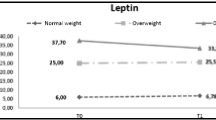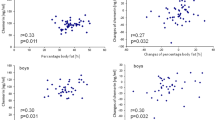Abstract
The aim of this study was to evaluate the effect of a lifestyle intervention programme (nutrition and exercise counselling) on metabolic syndrome (MS) components, adipokines (leptin, adiponectin) and ghrelin levels in overweight children. A total of 61 overweight children aged 7–9 years (≥85th body mass index (BMI) percentile; 27 boys/34 girls) were randomly assigned and completed a 1-year individual (IT) or group-based treatment (GT). Anthropometric and biochemical parameters were assessed at baseline, at 6 months and at 1 year. Twenty-two normal weight children (<85th BMI percentile; 7–9 years old; 13 boys/nine girls) were also evaluated at baseline. Insulin resistance (IR) was determined by the homeostasis model assessment of IR (HOMA-IR). Overweight children presented significantly higher blood pressure, triglycerides, apolipoprotein B, insulin, HOMA-IR, leptin, C-reactive protein and homocysteine levels, while apolipoprotein A-I was significantly lower. At baseline, MS was present in ten overweight children, of which only five maintained it at 1 year. Leptin and ghrelin levels were associated with IR and MS components. MS was predicted by apolipoprotein A-I, insulin and pre-puberty. The lifestyle intervention led to a significant improvement in standard deviation score of BMI, waist circumference/height ratio and lipid profile. Changes in insulin, HOMA-IR, leptin and adiponectin were not significant. Ghrelin behaved differently between IT and GT. The GT intervention seems to be more successful, with a decrease in BMI Z-score and an improvement of metabolic parameters. In conclusion, overweight children have multiple risk factors associated with MS. A lifestyle intervention programme seems to be an effective mean for reducing obesity and MS components and improving adipokines concentrations.

Similar content being viewed by others
Abbreviations
- BMI:
-
Body mass index
- BP:
-
Blood pressure
- CDC:
-
Centers of Disease Control
- CRP:
-
C-reactive protein
- CVD:
-
Cardiovascular diseases
- GT:
-
Group-based treatment
- HDL:
-
High-density lipoprotein
- HOMA-IR:
-
Homeostasis model assessment of insulin resistance
- IT:
-
Individual treatment
- MS:
-
Metabolic syndrome
- SD:
-
Standard deviation
- TG:
-
Triglycerides
- WC:
-
Waist circumference
- zBMI:
-
Standard deviation score of body mass index
References
Bacha F, Arslanian SA (2005) Ghrelin suppression in overweight children: a manifestation of insulin resistance? J Clin Endocrinol Metab 90:2725–2730
Bobbert T, Rochlitz H, Wegewitz U et al (2005) Changes of adiponectin oligomer composition by moderate weight reduction. Diabetes 54:2712–2719
Centers for Disease Control and Prevention. CDC growth charts: United States. Percentile data files with LMS values. http://www.cdc.gov/growthcharts/zscore.htm. Accessed 13 Jan 2004
Cook S, Weitzman M, Auinger P et al (2003) Prevalence of a metabolic syndrome phenotype in adolescents: findings from the third National Health and Nutrition Examination Survey, 1988–1994. Arch Pediatr Adolesc Med 157:821–827
Cruz ML, Goran MI (2004) The metabolic syndrome in children and adolescents. Curr Diab Rep 4:53–62
Dandona P, Alijada A, Chaudhuri A et al (2005) Metabolic syndrome: a comprehensive perspective based on interactions between obesity, diabetes, and inflammation. Circulation 111:1448–1454
De Ambrogi M, Volpe S, Tamanini C (2003) Ghrelin: central and peripheral effects of a novel peptydil hormone. Med Sci Monit 9:R217–R224
Dietz WH (1998) Health consequences of obesity in youth: childhood predictors of adult disease. Pediatrics 101:518–525
Dubose KD, Stewart EE, Charbonneau SR et al (2006) Prevalence of the metabolic syndrome in elementary school children. Acta Pediatr 95:1005–1011
Garipağaoğlu M, Sahip Y, Darendeliler F et al (2009) Family-based group treatment versus individual treatment in the management of childhood obesity: randomized, prospective clinical trial. Eur J Pediatr 168:1091–1099
Gilardini L, McTernan PG, Girola A et al (2006) Adiponectin as a candidate marker of metabolic syndrome in obese children and adolescents. Atherosclerosis 189:401–407
Gil-Campos M, Aguilera CM, Cañete R, Gil A (2006) Ghrelin: a hormone regulating food intake and energy homeostasis. Br J Nutr 96:201–226
Goran MI, Gower BA (2001) Longitudinal study on pubertal insulin resistance. Diabetes 50:2444–2450
Han R, Lai R, Ding Q et al (2007) Apolipoprotein A-I stimulates AMP-activated protein kinase and improves glucose metabolism. Diabetologia 50:1960–1968
Hoffstedt J, Arvidsson E, Sjölin E et al (2004) Adipose tissue adiponectin production and adiponectin serum concentration in human obesity and insulin resistance. J Clin Endocrinol Metab 89:1391–1396
Huang TTK, Nansel TR, Belsheim AR, Morrison JA (2008) Sensitivity, specificity, and predictive values of pediatric metabolic syndrome components in relation to adult metabolic syndrome: The Princeton LCR Follow-up Study. J Pediatr 152:185–190
Johnston CA, Tyler C, McFarlin BK et al (2007) Weight loss in overweight Mexican American children: a randomized, controlled trial. Pediatrics 120:e1450–e1457
Kelishadi R, Hashemipour M, Mohammadifard N et al (2008) Short- and long-term relationships of serum ghrelin with changes in body composition and the metabolic syndrome in prepubescent obese children following two different weight loss programmes. Clin Endocrinol 69:721–729
Klimcakova E, Kovacikova M, Stich V, Langin D (2010) Adipokines and dietary interventions in human obesity. Obes Rev 11:446–456. doi:10.1111/j.1467-789X.2009.00704.x
Körner A, Kratzsch J, Gausche R et al (2007) New predictors of the metabolic syndrome in children—role of adipocytokines. Pediatr Res 61:640–645
Kuczmarski RJ, Ogden CL, Grummer-Strawn LM et al (2000) CDC growth charts: United States. Adv Data 314:1–28
Lara-Castro C, Yuchang F, Chung H, Garvey WT (2007) Adiponectin and the metabolic syndrome: mechanisms mediating risk for metabolic and cardiovascular disease. Curr Opin Lipidol 18:253–270
Mathews DR, Hosker JP, Rudenski AS et al (1985) Homeostasis model assessment: insulin resistance and beta cell function from fasting plasma glucose and insulin concentration in man. Diabetologia 28:412–419
McCarthy HD, Jarret KV, Crawley HF (2001) The development of waist circumference percentiles in British children aged 5.0–16.9y. Eur J Clin Nutr 55:902–907
Monzavi R, Dreimane D, Geffner ME et al (2006) Improvement in risk factors for metabolic syndrome and insulin resistance in overweight youth who are treated with lifestyle intervention. Pediatrics 117:e1111–e1118
Nagaya N, Kojima M, Uematsu M et al (2001) Hemodynamic and hormonal effects of human ghrelin in healthy volunteers. Am J Physiol Regulatory Integrative Comp Physiol 280:R1483–R1487
National High Blood Pressure Education Program Working Group on High Blood Pressure in Children and Adolescents (2004) The fourth report on the diagnosis, evaluation, and treatment of high blood pressure in children and adolescents. Pediatrics 14:555–576
Pedrosa C, Correia F, Seabra D et al (2009) Prevalence of overweight and obesity among 7–9 year-old children in Aveiro, Portugal: comparison between IOTF and CDC references. Public Health Nutr. doi:10.1017/S1368980009991789
Raitakari OT, Porkka KVK, Riinnemaa T et al (1995) The role of insulin in clustering of serum lipids and blood pressure in children and adolescents—The Cardiovascular Risk in Young Finns Study. Diabetologia 38:1042–1050
Reinehr T, de Sousa G, Toschke AM, Andler W (2007) Comparison of metabolic syndrome prevalence using eight different definitions: a critical approach. Arch Dis Child 92:1067–1072
Reinehr T, Kleber M, Toschke AM (2009) Lifestyle intervention in obese children is associated with a decrease of the metabolic syndrome prevalence. Atherosclerosis 207:174–180
Saland JM (2007) Update on the metabolic syndrome in children. Curr Opin Pediatr 19:183–191
Semiz S, Rora S, Özdemir Ö et al (2008) Are C-reactive protein and homocysteine cardiovascular risk factor in obese children and adolescents? Pediatr Int 50:419–423
Steinberger J, Steffen L, Jacobs DR et al (2003) Relation of leptin to insulin resistance syndrome in children. Obes Res 11:1124–1130
Sung RYT, Yu CW, Chang SKY et al (2002) Effects of dietary intervention and strength training on blood lipid level in obese children. Arch Dis Child 86:407–410
Tanner J (1962) Growth at adolescence, 2nd edn. Blackwell Scientific, Oxford
The Expert Committee on the Diagnosis and Classification of Diabetes Mellitus (2003) Follow-up report on the diagnosis of diabetes mellitus. Diab Care 26:3160–3167
Valle M, Martos R, Gascón F et al (2005) Low-grade systemic inflammation, hypoadiponectinemia and a high concentration of leptin are present in very young obese children, and correlate with metabolic syndrome. Diabetes Metab 31:55–62
Vasseur F, Meyre D, Froguel P (2006) Adiponectin, type 2 diabetes and the metabolic syndrome: lessons from human genetic studies. Expert Rev Mol Med 8:1–12
Wang Y, Lobstein T (2006) Worldwide trends in childhood overweight and obesity. Int J Pediatr Obes 1:11–25
Wärnberg J, Marcos A (2008) Low-grade inflammation and the metabolic syndrome in children and adolescents. Curr Opin Lipidol 19:11–15
Wauters M, Considine RV, Van Gaal LF (2000) Human leptin: from an adipocyte hormone to an endocrine mediator. Eur J Endocrinol 143:293–311
Weiss R, Dziura J, Burget TS et al (2004) Obesity and the metabolic syndrome in children and adolescents. N Engl J Med 350:2362–2374
Whatmore AJ, Hall CM, Jones J et al (2003) Ghrelin concentrations in healthy children and adolescents. Clin Endocrinol 59:649–654
Whitehead JP, Richards AA, Hickman IJ et al (2006) Adiponectin—a key adipokine in the metabolic syndrome. Diabetes Obes Metab 8:264–280
World Health Organization (1995) Physical status: the use and interpretation of anthropometry. Report of a WHO Expert Committee. World Health Organ Tech Rep Ser 854:1–452
Yamauchi T, Kadowaki T (2008) Physiological and pathophysiological roles of adiponectin and adiponectin receptors in the integrated regulation of metabolic and cardiovascular diseases. Int J Obes 32:s13–s18
Yoshinaga M, Sameshima K, Tanaka Y et al (2008) Adipokines and the prediction of the accumulation of cardiovascular risk factors or the presence of metabolic syndrome in elementary school children. Circ J 72:1874–1878
Zimmet P, Alberti G, Kaufman F et al (2007) The metabolic syndrome in children and adolescents. Lancet 23:2059–2061
Acknowledgements
We thank the children and the parents who participated in the study. We also like to thank to the nurse Fernanda Gomes for assistance and to the endocrinologist Joana Guimarães for review and comments. This work was supported by a Sociedade Portuguesa de Endocrinologia, Diabetes e Metabolismo/ABBOTT grant.
Conflict of interest
None.
Ethical standards
The research protocol was approved by the Ethics Committee of the Hospital Infante D. Pedro and informed consent was obtained from the children’s parents.
Author information
Authors and Affiliations
Corresponding author
Rights and permissions
About this article
Cite this article
Pedrosa, C., Oliveira, B.M.P.M., Albuquerque, I. et al. Metabolic syndrome, adipokines and ghrelin in overweight and obese schoolchildren: results of a 1-year lifestyle intervention programme. Eur J Pediatr 170, 483–492 (2011). https://doi.org/10.1007/s00431-010-1316-2
Received:
Accepted:
Published:
Issue Date:
DOI: https://doi.org/10.1007/s00431-010-1316-2




